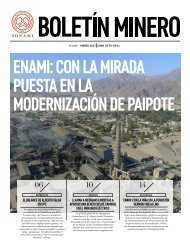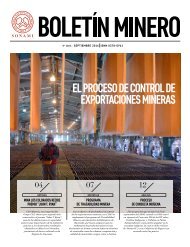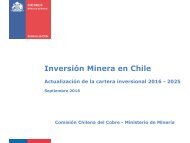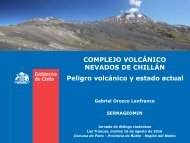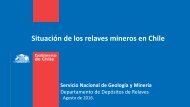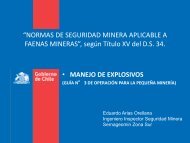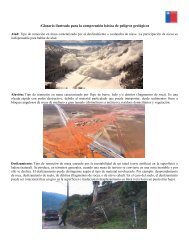Catastro-de-Medidas-y-Tecnologias
Catastro-de-Medidas-y-Tecnologias
Catastro-de-Medidas-y-Tecnologias
You also want an ePaper? Increase the reach of your titles
YUMPU automatically turns print PDFs into web optimized ePapers that Google loves.
PREVENCIÓN/CONTROL<br />
VENTAJAS/DESVENTAJAS<br />
REQUERIMIENTOS DE<br />
MANTENIMIENTO<br />
EFICIENCIA<br />
Ventajas<br />
• Gestión <strong>de</strong> materiales <strong>de</strong><br />
distinta naturaleza que se<br />
encuentran en una faena minera.<br />
• Reducción <strong>de</strong> la tasa <strong>de</strong><br />
generación <strong>de</strong> aci<strong>de</strong>z y lixiviación<br />
<strong>de</strong> metales por precipitación <strong>de</strong><br />
los metales en el interior <strong>de</strong> la<br />
instalación.<br />
Desventajas<br />
• Son muchos los factores que<br />
condicionan el éxito <strong>de</strong> esta<br />
medida (grado y homogeneidad <strong>de</strong><br />
la mezcla, naturaleza <strong>de</strong>l contacto,<br />
tamaño <strong>de</strong> partículas, etc.).<br />
El material estéril <strong>de</strong>be tener<br />
un potencial suficiente <strong>de</strong><br />
neutralización para mantener<br />
las condiciones alcalinas. En<br />
caso contrario se hace necesario<br />
adicionar material consumidor <strong>de</strong><br />
ácido como calizas.<br />
El uso <strong>de</strong> capas o cubiertas<br />
<strong>de</strong> caliza es más eficiente<br />
en ambientes con alta<br />
precipitación.<br />
A menor tamaño <strong>de</strong> partícula<br />
o granulometría, el efecto<br />
<strong>de</strong>l material neutralizador<br />
aumenta.<br />
La eficiencia <strong>de</strong> esta medida es<br />
muy variable, ya que <strong>de</strong>pen<strong>de</strong> <strong>de</strong><br />
muchos factores:<br />
• Método <strong>de</strong> aplicación.<br />
• Tamaño <strong>de</strong>l material.<br />
• Flujo hidráulico <strong>de</strong>l agua y<br />
efluentes en el interior <strong>de</strong> la<br />
Fuente.<br />
• Precipitación esperada.<br />
• Etc.<br />
La eficiencia está directamente<br />
relacionada con la realización<br />
previa <strong>de</strong> ensayos pilotos a<br />
distintas escalas.<br />
EJEMPLO DE APLICACIÓN<br />
En la Mina Samatosum en Canadá, la roca estéril<br />
fue clasificada antes <strong>de</strong> la explotación como material<br />
potencial generador <strong>de</strong> ácido (PAG) o no generador<br />
<strong>de</strong> ácido (NAG) <strong>de</strong> acuerdo a la litología. Según los<br />
resultados <strong>de</strong> ensayos en columnas, el bota<strong>de</strong>ro fue<br />
construido siguiendo un diseño en capas alternantes<br />
<strong>de</strong> material PAG y material NAG (MEND, 1998).<br />
COMENTARIOS<br />
Esta medida supone el aprovechamiento <strong>de</strong>l<br />
material alcalino presente en una faena minera,<br />
significando un gran aporte costo-eficiente en la<br />
gestión <strong>de</strong>l drenaje minero.<br />
MÁS INFORMACIÓN<br />
• Andrina, J., Wilson, W., and Miller, S., 2009. Behavior of water flow and geochemical mixing in layered<br />
waste rock stockpiles: a meso-scale experiment. In: Proc. Securing the Future and 8th Internat. Conf. on<br />
Acid Rock Drainage, June 22–26, 2009, Skellefteå, Swe<strong>de</strong>n.<br />
• MEND, 1998. Blending and Layering Waste Rock to Delay, Mitigate or Prevent Acid Rock Drainage and<br />
Metal Leaching: A Case Study Review. MEND Project 2.37.1.<br />
• Sahoo P.K., Kim, K., Equeenuddin, S.M., and Powell, M.A., 2013. Current approaches for mitigating acid<br />
mine drainage. RevEnvironContamToxicol 226, 1-32.<br />
17



